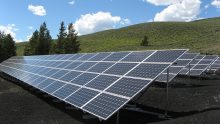The Department of Energy (DOE) announced it will fund up to $220 million of R&D projects to modernize America’s aging power grid infrastructure over the next three years. Accompanying this, DOE released its ¨Grid Modernization Multi-Year Program Plan¨ (MYPP), a strategic blueprint that informs and guides a national R&D agenda involving a consortium of DOE National Laboratories.
The Grid Modernization Laboratory Consortium (GMLC) is made up of 14 DOE National Laboratories and dozens of industry, academia, and state and local government agency partners across the country, according to a DOE news release.
DOE is providing funding for an initial set of 88 grid modernization projects. While a few focus specifically on microgrids, many, if not all, of them will advance development of power technologies that could be of use to microgrid project developers, utilities and other relevant stakeholders.
In addition to the recently established Microgrid System Laboratory, the Grid Modernization Program reflects the potential for a distributed, smarter energy system to meet national energy objectives such as decarbonization, energy independence, and resilience from storms and terrorist attacks.
Reducing Electricity and Carbon Emissions Costs
Enhancing the security, reliability and resiliency of U.S. grid infrastructure and reducing carbon emissions are among the main objectives of DOE’s grid modernization plan and the new R&D funding, Energy Secretary Ernest Moniz explained.
“Modernizing the U.S. electrical grid is essential to reducing carbon emissions, creating safeguards against attacks on our infrastructure, and keeping the lights on,” Secretary Moniz was quoted as saying.
¨This public-private partnership between our National Laboratories, industry, academia, and state and local government agencies will help us further strengthen our ongoing efforts to improve our electrical infrastructure so that it is prepared to respond to the nation’s energy needs for decades to come.”
Microgrids and DOE’s Grid Modernization Initiative
A full list of the Grid Modernization Initiative projects, participating laboratories and partners, as well as additional information is available on DOE’s website. Among them, UPS, Waste Management, Burns McDonnell, Harshaw Trane, LG&E and the State of Kentucky will carry out a 2-year, $1 million ¨Industrial Microgrid Analysis and Design for Energy Security and Resiliency.¨
Also directed specifically at advancing microgrid technology, Alaska state agencies, universities and Intelligent Energy systems have banded together to form the Alaska Microgrid Partnership, which is to develop a programmatic approach and framework that provides the basis for stakeholders to reduce diesel fuel consumption in remote microgrids by at least 50 percent and improve system reliability, security and resiliency without increasing system lifecycle costs.
The DOE National Renewable Energy Laboratory (NREL) is participating in 44 of the 88 initial grid modernization R&D projects. GMLC co-chair and NREL Associate Laboratory Director Bryan Hannegan highlighted how GMLC illustrates a promising new approach to leveraging the resources of DOE National Labs, academic researchers and private sector power industry participants.
New Approaches to Grid Modernization Paying Dividends
“The Grid Modernization Laboratory Consortium is a new way of efficiently leveraging the strengths and capabilities of America’s national laboratories to deploy new concepts and technologies that will make the grid cleaner, more productive, and more secure,¨ Hannegan stated.
¨The projects announced today are an important first step towards achieving the DOE vision of a modernized grid for the nation.”
DOE has invested more than $4.5 billion in grid modernization and smart grid projects via American Recovery & Reinvestment Act funding. Those investments are paying dividends in communities throughout the nation, reducing electricity costs while at the same time improving efficiency, reliability, resiliency and security, DOE highlights.
¨In Tennessee, for example, as a result of Chattanooga’s Smart Grid Investment Grant (SGIG) project, reliability increased by 45 percent. In Georgia, an electric cooperative deployed advanced metering infrastructure under the SGIG program, and reduced its operational costs by 65 percent. Service is restored faster after weather-related grid outages and emissions have been reduced. In addition, consumers are now able to better manage their own consumption, saving money and electricity.¨
- Argonne National Laboratory
- Brookhaven National Laboratory
- Lawrence Berkeley National Laboratory
- Lawrence Livermore National Laboratory
- National Renewable Energy Laboratory
- Pacific Northwest National Laboratory
- Sandia National Laboratory
- Los Alamos National Laboratory
- SLAC National Accelerator Laboratory
- Idaho National Laboratory
- Savannah River National Laboratory
- Oak Ridge National Laboratory
- National Energy Technology Laboratory
- New Brunswick Laboratory
Project 8: Industrial Microgrid Analysis and Design for Energy Security and Resiliency
Investigation, development, and analysis of the risks, costs, and benefits of a microgrid utilizing renewable energy systems at the UPS WorldPort and Centennial Hub facilities. Develop a roadmap to help industries evaluate microgrid adoption by defining institutional and regulatory challenges associated with development of industrial-based resilient systems.
Partners: ORNL, SNL, United Parcel Service, Waste Management, Burns McDonnell, Harshaw Trane, LG&E, State of Kentucky
Project 9: DER Siting and Optimization Tool for California
Deliver to stakeholders an integrated distributed resource planning and optimization platform, hosted online, able to identify meaningful behind-the-meter DER adoption patterns, potential microgrid sites and demand-side resources, and evaluate the impacts of high renewable penetration feeders on the distribution and transmission grid.
Partners: ANL, BNL, LBNL, LLNL, NREL, SLAC, California PUC, Pacific Gas and Electric (PG&E), Southern California Ediso (SCE), Metropolitan Council of Governments, New York State Energy Research and Development Authority (NYSERDA)
Project 10: Smart Reconfiguration of Idaho Falls Network
Improve physical security of the Idaho Falls distribution system by testing smart reconfiguration, intelligent DR utilizing loads as a resource, controlled islanding, black start procedures for emergency service, and resynchronization in the presence of DERs.
Partners: PNNL, INL, Idaho Falls Power, Schweitzer Engineering Labs, Washington State University, Utah Associated Municipal Power Systems
Project 13: Alaska Microgrid Partnership
Develop a design basis framework and programmatic approach to assist stakeholders in their efforts to reduce diesel fuel consumption by at least 50% in Alaska’s remote microgrids without increasing system lifecycle costs, while improving overall system reliability, security, and resilience.
Partners: NREL, PNNL, LBNL, SNL, Alaska Energy Authority, University of Alaska- Fairbanks, University of Alaska- Anchorage, Renewable Energy Alaska Project, Intelligent Energy Systems
Project 17: Transactive Campus Demonstration
Three campuses (PNNL, UW and WSU) will develop and test a range of tranactive control activities on each of the 3 campuses. They will also develop the ability to coordinate across these three campuses to provide coordinated services to the PNW power system and their serving distribution utilities based upon the transactive response of key loads on the campuses. The UW will emphasize energy storage and coordination for peak management and provision of flexibility. The WSU campus will leverage its microgrid and major campus loads and thermal storage to deliver transactive response. And PNNL will advance controls in its new SEB grid building and other campus loads to help the City of Richland better manage it’s demand limits. OE and BTO collaborated in the design and cost share of the project.
Partners: PNNL, Washington State Clean Energy Fund, University of Washington, Washington State University





